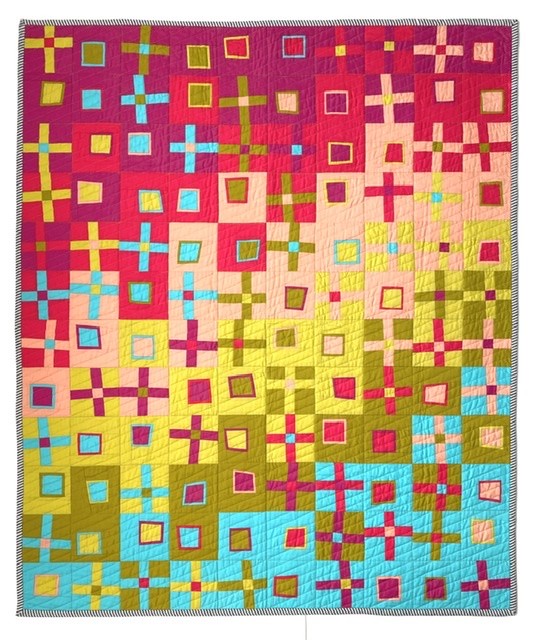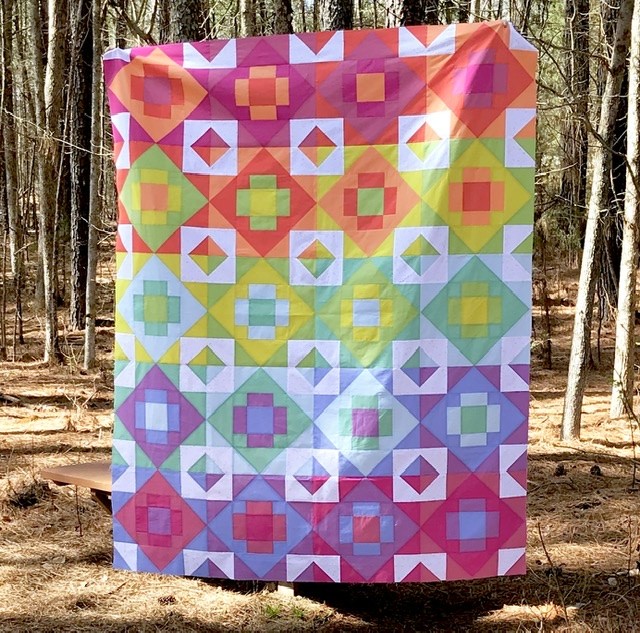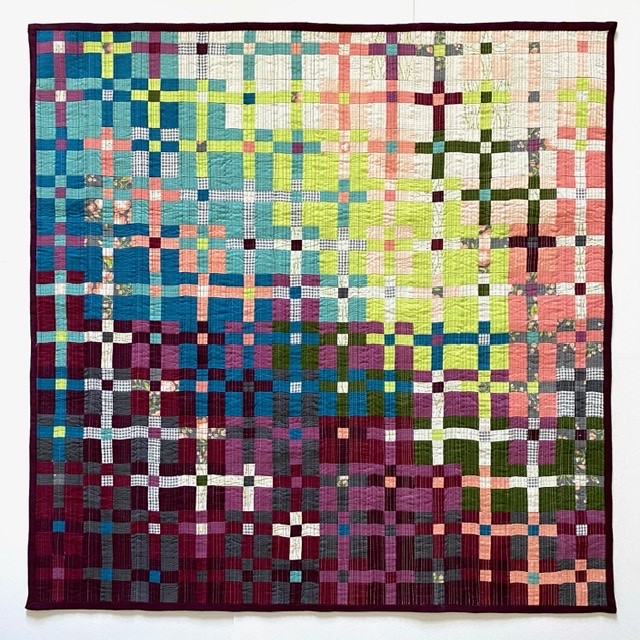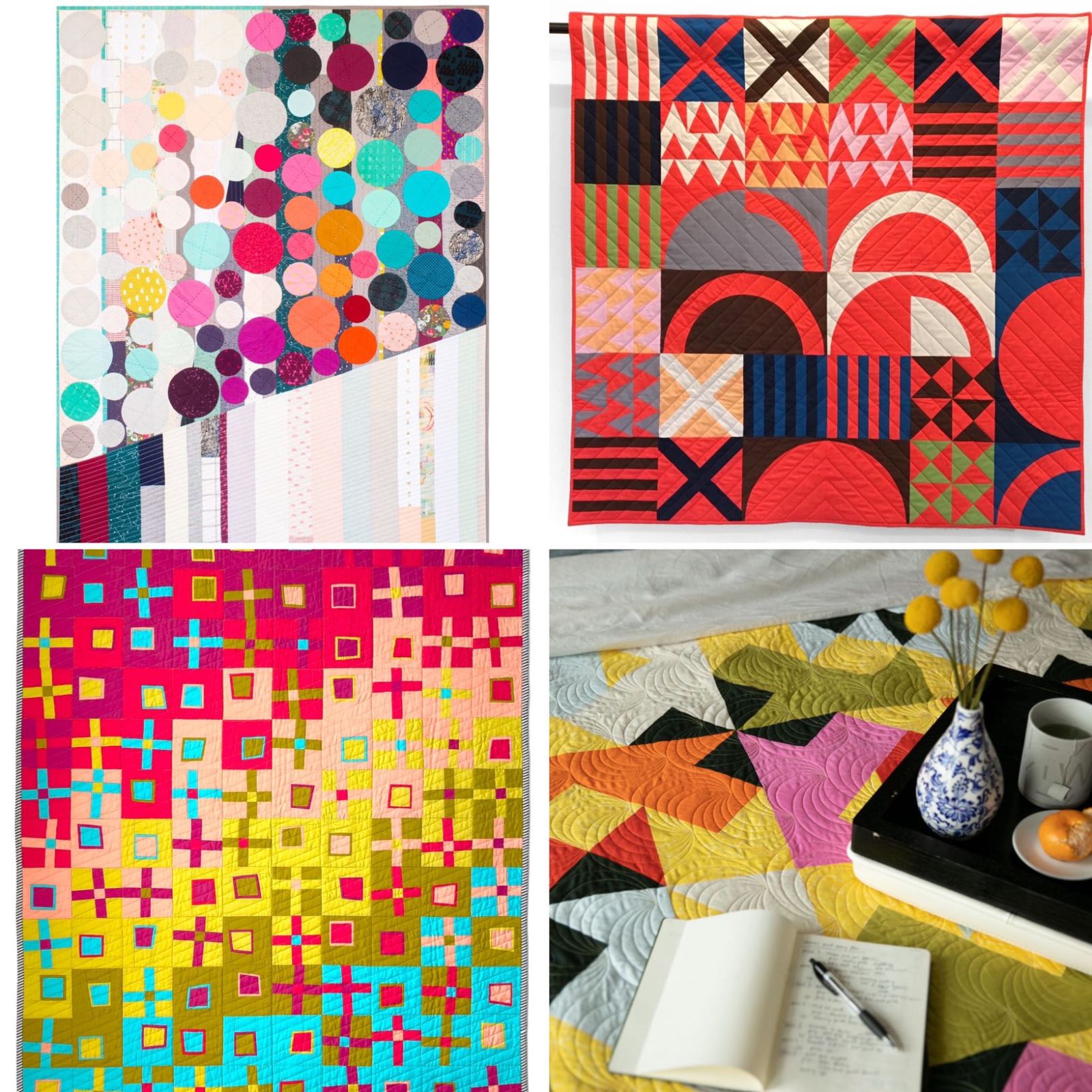In this new showcase I’m featuring four Modern Quilters that you will love!
Wendy Chow
I’m Wendy, an Aussie modern quilt designer and pattern writer based in New York City. I also co-host a quilting podcast, Quilt Buzz. I have a deep love for prints and patterns. My design style stems from repeating geometric patterns in traditional quilt blocks, architecture, interior design and nature. If you scroll through my Instagram account, you’ll find lots of bold and unexpected colour combinations.
My quilting journey did not begin like most quilters. It wasn’t passed down from my grandmother or mother. It all started in 2015 in my parents’ dining room where my sister spent her spare time making quilts for friends and family. The intricate quilt designs, fabrics and process sparked my interest to explore the art of quilting. With the basics from high school home economics class, I taught myself how to quilt.
The Weekend Quilter didn’t start a couple of years into my quilting journey. My previous day job was demanding and the hours were long. Working overtime (sometimes through the early hours), bringing work home and working during the weekends were the norm. Finding the time and energy to channel my creativity was a challenge.
I started my ‘Quiltstagram’ account – @the.weekendquilter – in early-2017 to hold myself accountable to live a more balanced life. Discovering different accounts and connecting with other members in the online quilting community were what kept me motivated to continue making and sharing. The Weekend Quilter is my creative outlet. It was a way for me to decompress and keep thoughts away from my day job.
Since relocating to the United States in late-2018, I have left the corporate world and put 100% of my time into The Weekend Quilter. Despite circumstances having changed and I spend more of my weekdays making, I continue to view myself as The Weekend Quilter and everyone as one too. We all live very different lives with various levels of responsibility. Whether you work full-time, part-time, shift work, a full-time parent or retired, we’re all weekend quilters. We make time during the week to create and channel our inner creativity.
For more quilty adventures, tips, tutorials and the latest updates you can follow me @the.weekendquilter on Instagram. I’ll also be releasing a quilting book with 10 quilt patterns for the modern-day home on Jan 19, 2021 called Urban Quilting.
Instagram| @the.weekendquilter
Website| www.the-weekendquilter.com
Email| the.weekendquilter@gmail.com


Charles Cameron
I’m Charles Cameron, the quilter behind the @FeltLikeSweets Instagram account. I’m an Engineer by training and work with the left side of my brain all day, so I tend toward arts-y, crafts-y, creative endeavors to exercise the right side of my brain and to feel balanced.
I have two young daughters who are my creative inspirations. Their playful experimentation and approach to learning has continued to show me that not knowing how to do something can be a powerful enabler toward creating something extraordinary: to not be bound by ‘the ways that others do things,’ or ‘the ways that things ought to be done.’ And most importantly to view mistakes and mishaps as lessons rather than failures.
Here’s the story of my first quilt. I started it not knowing that it was going to become a quit; not actually knowing how a quilt was made. Really!
I had become inspired by several improv quilts that kept popping up in my Instagram feed. One was a wonky cross quilt by Jill Fisher (@Pieladyquilts); the crosses appear to dance and sparkle across the quilt top. I found myself determined to replicate the look of her graceful ‘dancing’ pluses.
I tried several different methods of making wonky pluses (and have a few doll blankets’ worth of experiments) before landing on a method that used strip piecing and trimming of blocks after construction to achieve an improv look. I switched my attention to another Jill Fisher design element – an outlined box, and repeated the cycle. After amassing 120 blocks, and while keeping a spreadsheet of the 3-color combinations so as not to repeat (that’s the Engineer in me) I figured that I had enough to make a decent sized quilt.

It is the definition of a beginner quilt. Aided by determination and educated by mistakes and mishaps, I constructed, quilted and bound this quilt without any training. It won 1st prize in the new entrant category of the North Carolina State fair in 2019!
I have since written a pattern for this quilt, available in my Etsy shop, for any advanced beginner who wants the look and feel or improv, but who isn’t quite ready to give up their ruler.
Since that first quilt, I have approached each new project with a similar inquisitive and unbound approach. Don’t get me wrong, patterns are great! But I treat them as suggestions, recommendations and a starting point, just as would an ambitious home cook who doesn’t have all the ingredients for a dish they are craving.
I also enjoy using bright colors, often solids, and like to make ‘rules’ or ‘constraints’ about how colors are placed that help create a secondary pattern or flow within the quilts that make them sparkle. You can see this in this Meadowland quilt that I made (Pattern by Meghan Buchanan, Then Came June). Here, I constrained each row of blocks to 4 colors. The color placement of each of the 4 colors are rotated in their position from one block to the next across the row. 2 of 4 colors are repeated in the next row, and 2 new colors are added, and the color rotation continues. I think this approach really makes one’s eyes search and stare at the quilt, seeking to find the pattern that may not be obvious at first glance.

Color value and graphic elements are a go-to recipe for my original work. Here, in ‘Bright Blooms on a Lattice’ I marry bold and bright bursts of color against a rigid grid to suggest blooms and vines dancing about a lattice. I constructed the entire quilt using a single 3-color cross block, but play with color value combinations and their positions to make the cross grid protrude or recede in different locations so as to undulate across this quilt.

We’ve certainly established that I love to plan things out beforehand. But I’ve also found practicing some improv piecing can really help open one’s mind to new possibilities. Just playing around with some scraps and without a master plan can be a great enabler for discovering new ideas.
Here’s an example of where I started with a small collection of solid scraps that I purchased online (and vowed to use them all and add no more). Every few days I pulled out a few of these scraps, cut them up and sewed them back together — improv style. It was a great way for me to explore without the pressures of adhering to a pattern or a plan, and I knew when it was done when all the scraps had been used.


Laura Loewen
My mom taught me to sew as a young child over 30 years ago. While exhibiting garment sewing at the state fair, I was seated next to a peer who talked to me the entire day about quilting. I was intrigued because I had a vague memory of attending a quilt guild meeting with my mom when I was younger. We had a bookshelf at home of quilt books, so I selected a simple pinwheel pattern. And there I was, a teenager in the mid-90’s who just became a quilter. I continued to sew quilts over the years but was never hooked in by the traditional patterns or fabrics.
In the 00’s I looked for inspiration in patterns and motifs I found during my job as an interior designer. I liked clean, bright colors and crisp, geometric lines. I still find inspiration in bright colors and geometric designs, but I also look to traditional quilt shapes that can be interpreted in a modern way instead of just trying to ignore the history of quilting. I am drawn to Abstract and Abstract Expressionist art and try to apply color and movement to my quilts as if they were paintings.
My entire life I have identified as an artist, as far back as I can remember. I have experimented with all kinds of two-dimensional media, pencil, charcoal, paints, pastels, etc. I struggled with identifying as a textile artist for several years because I was not looking at quilting through an artist’s eye, or with the eye of making my own rules and my own style. With modern quilting I am free to experiment with different techniques and interpretations of technique. There are no real rules about having to make a certain way or get the same result every time. The past few years I have really focused on honing my color palette, mostly bright tertiary colors, the shapes that interest me, half-square triangles, perfect circles, and squares/rectangles, and techniques I like to include in my quilts, ruler free improv, big stitch quilting, straight line quilting, and applique. Quilting is now my preferred medium and I am comfortable defining myself as an artist again wielding a needle and thread.



Diana Vandeyar
I am a modern quilter and textile artist with a deep appreciation of craftsmanship and design. I love juxtaposing contemporary techniques and bold colours with traditional elements. Working with unusual colour palettes is exciting for me and I believe any combination can work when a light/dark/bright/dull balance is achieved. My quilts explore modern traditionalism (experimenting with traditional blocks), graphic design (geometry and large fields of colour), and improv (free-form reinterpretation of classic blocks). I design on a computer using the EQ8 software which allows me to change the layout and colours very quickly.
“Log Cabin Quilter Unknown” Inspired by a close-up photo I took at the Virginia Quilt Museum. The disassociation of the details from the whole quilt was very intriguing. I changed the colouring, shifted the alignment, and changed the scale of each of the blocks to add another dimension to the quilt.
“Grandmother’s Life on Mars” Inspired by the 1970’s quilting revival. The design is created using my improv hexagon technique, experimenting with the clash between the past (traditional) and the now (modern).
“The Urbans Sampler Quilt” This quilt uses dynamic colour combinations and eclectic block placements for maximum graphic impact. Free pattern tutorial at www.dianavandeyar.wordpress.com
Instagram Account: @dianavandeyar



- The Power of Contrast: How Value Shapes Visual Impact in Quilts
- Improvisation in Quilting: Embracing the Unexpected as Creative Power
- The Global Revival of Textile Art — Latin American Voices Leading the Way
- Modern Quilters Showcase 63
- Free Janome Quilting Tutorials by Carolina Oneto: Projects, Patterns & Techniques


